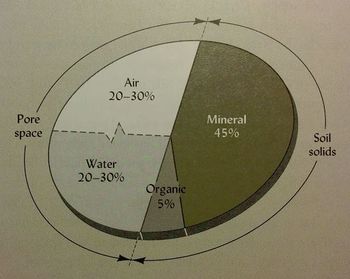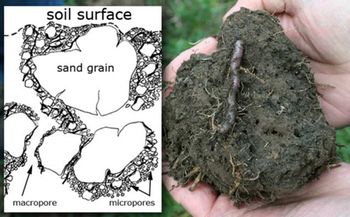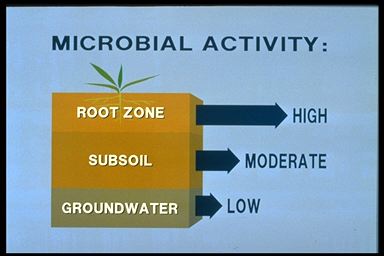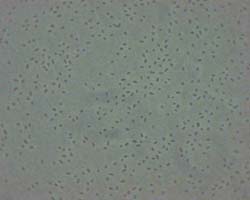Soil Environment: Difference between revisions
No edit summary |
|||
| Line 29: | Line 29: | ||
[[Image:Soilenv_figure2.jpeg|350px|thumb|right|Figure 2. High residue and cover crops contribute organic matter to soil which helps aggregates and structure build up. [11]]] | [[Image:Soilenv_figure2.jpeg|350px|thumb|right|Figure 2. High residue and cover crops contribute organic matter to soil which helps aggregates and structure build up. [11]]] | ||
Soil structure is the arrangement of primary soil particles into aggregates which describes the arrangement of the solid parts of the soil and the pore spaces between them. Soil structure has a major influence on water movement, SOM leaching, and gas exchanges of the soils. The water movement, affected by structure can bring SOM in the surface to deep inside the soil. Soil with high clay content and/or poor structure, may have reduced infiltration and will cause runoff, erosion and surface crusting. [11] This can cause nutrient loss and increase the potential of desertification. | Soil structure is the arrangement of primary soil particles into aggregates which describes the arrangement of the solid parts of the soil and the pore spaces between them. Soil structure has a major influence on water movement, SOM leaching, and gas exchanges of the soils. The water movement, affected by structure can bring SOM in the surface to deep inside the soil. Soil with high clay content and/or poor structure, may have reduced infiltration and will cause runoff, erosion and surface crusting. [11] This can cause nutrient loss and increase the potential of desertification. | ||
==Physical Factors== | ==Physical Factors== | ||
Revision as of 02:12, 15 March 2016
Introduction
The soil environment consists of a variety of physical, biological and chemical factors that affect the abundance and diversity of microbes found in the soil. [4] At its basic level, the soil environment consists of a solid and porous fraction. Within these fractions, a variety of chemical and physical factors are affected by and and affect microbes. These include, but are not limited to texture, temperature, pH, oxygen, cation exchange capacity and redox reactions.
The soil environment directly affects the types of microbes, as well as the rates of processes they perform. For example, microbial activity increases with temperature, which in turn affects rates of decomposition. On the other hand, microbial processes directly affect their environments as well, contributing to the carbon and nitrogen cycles, which are important for microbial and plant health. [5] At the micro scale, bacteria and other microbes participate in a variety of reactions that affect nutrient cycling, pH, as well as oxygen and CO2 content. At the macro scale, these processes can change the landscape in drastic ways, assisting in weathering of the soil and development of soil layers.
Soil Environment Overview
Solid Fraction
The solid fraction of the soil consists of mineral and organic matter, which is typically about 50% of the soil by volume (see figure 1), and it has a dominant influence on heat, water, and chemical transport and retention process. [4] Most of the solid particles are derived from mineral sources such as decomposed rocks or sediments. [13] Soil organic matter (SOM) consists of all of the organic components of a soil, including living biomass, decomposing tissue, and fully decomposed tissue called humus. [5] The rate and pathway of carbon decomposition and SOM formation directly affects the carbon cycle . Texture can also influence chemical properties such as cation exchange capacity (CEC). Finer textured soils with high clay content will have great CEC than soils with low clay content.
Soil Pores
Soil pores consist of the air and water filled fractions of the soil, and together they make up about 50% of the soil by volume. Pore space is largely determined by size and arrangement of aggregates and affects the movement of water, air, and organisms in soil. Soil pores are typically classified based on size: Macropores ( >75um) Mesopores ( 30-70um) Micropores ( 5-30um) Ultramicropores (0.1-5um) Cryptoporus ( <0.1um). [5]
The air filled pores of the soil typically have a similar distribution of gases as the atmosphere above the soil, with slightly lower oxygen and slightly more CO2. The soil atmosphere consists of about 18-20% oxygen near the surface, which decreases with depth. CO2 is around 1%, and N2 is about 78% of the soil air filled pore space. [5] Oxygen (O2) content will be lower when available carbon is high (high O2 demand). Soil that is high in clay content and/or compacted may have trouble exchanging gases to the atmosphere. Soil air generally has a very high moisture content when compared to the atmosphere (~100% unless the soil is very dry). The amount and composition of air in a soil is largely determined by the water content in the soil. [4]
The main source of soil water is rainfall and overland flow. The amount of water that enters the soil is a function of soil structure and texture. Water moves in soil through mass flow and capillary action. The water in soil is often called the soil solution, which can move nutrients from the surface through the soil column. The water fraction of the pores is typically between 20 to 30% but can vary depending on precipitation, soil texture, and soil structure. The water content of a soil influences gas exchange, controls movement and concentrations of nutrients, and buffers the temperature of the soil. [5]
Soil Aggregates & Structure
Soil aggregates are groups of soil particles that bind to each other more strongly than to adjacent particles. The space between the aggregates provide pore space for retention and exchange of air and water. Aggregation affects erosion, movement of water, and plant root growth. [7] Polysaccharides produced by soil bacteria, and humic substances and hyphae produced by fungi improve aggregation.
Soil structure is the arrangement of primary soil particles into aggregates which describes the arrangement of the solid parts of the soil and the pore spaces between them. Soil structure has a major influence on water movement, SOM leaching, and gas exchanges of the soils. The water movement, affected by structure can bring SOM in the surface to deep inside the soil. Soil with high clay content and/or poor structure, may have reduced infiltration and will cause runoff, erosion and surface crusting. [11] This can cause nutrient loss and increase the potential of desertification.
Physical Factors
Soil Texture
Soil has the following types of texture: Sand (0.05-2.0 mm), Silt (0.002-0.05mm), and Clay ( < 0.002mm)[1]. Sands are loose and single-grained (that is, not aggregated together). They feel gritty to the touch and are not sticky. Each individual sand grain is of sufficient size that it can easily be seen and felt. Sands cannot be formed into a cast by squeezing when dry. Clay is the finest textured of all the soil classes. Clay usually forms extremely hard clods or lumps when dry and is extremely sticky and plastic when wet.[4] Soils that are coarse textured are less likely to have a well-defined structure and therefore fewer structured pore space than s soil high in clay content.[5]
Soil pores
Soil pores play a major role in water and air movement. Also, soil microorganisms reside in pores. Pore space is largely determined by size and arrangement of aggregates and affects the movement of water, air, and organisms in soil. Soil pore size distribution: Macropores ( >75um) Mesopores ( 30-70um) Micropores ( 5-30um) Ultramicropores (0.1-5um) Crytopores ( <0.1um). The average particle size could be determined by knowing the soil type and the percentage of sand, clay, and silt.
Soil Structure
Aggregation of primary soil particles is a critical determinant of soil structure.Structure is strongly affected by climate, biological activity, density and continuity of surface cover, and soil management practices. Soils that are coarse textured are less likely to have a well-defined structure and therefore fewer structured pore space than s soil high in clay content. Ecological relationships among soil organisms are influenced by soil structure.
Soil water
Soil water is essential for soil microorganisms. Without some water, there is no microbial activity. Sandy soils with large diameter particles (coarse texture) can contain less water than clay soils with small diameter particles (fine texture).[6] The formation of primary soil particles into soil aggregates creates an ideal environment for most bacteria. [1] As the amount of available water decreases, the ability to take up water in the soil differs among organisms. Fungal hyphae have the ability to extend through soil pores and obtain water, but bacteria do not share the same advantage.[1]
Temperature
Soil temperature greatly influences the rates of biological, physical, and chemical processes in the soil. Within a limited range, the rates of chemical reactions and biological processes double for every 10 degree increase.Soil temperature governs the rates and directions of soil physical processes and chemical reactions, and influences biological processed. Different pathogen species and strains have different thermal limits for survival, germination and infection.[5]
Soil aggregates
Soil aggregates are groups of soil particles that bind to each other more strongly than to adjacent particles. The space between the aggregates provide pore space for retention and exchange of air and water. Aggregation affects erosion, movement of water, and plant root growth. [7] Polysaccharides produced by soil bacteria and humic substances produced by fungi improve aggregation.
Biological Factors
Soil Fauna
Soil animals are divided into macrofauna (>2 mm, earthworms), mesofauna (0.1-0.2 mm, mites and nematodes), and microfauna (<0.1 mm, protozoa). These eukaryotes have a range of effects on microbial communities:
- Grazing: Grazing increases decomposition rates, freeing nutrients. Grazing also includes direct consumption of other organisms.
- Nutrient cycling: Soil fauna is responsible for up to 30% of the total soil mineralizable nitrogen. Additionally, soil fauna can remobilize nutrients as waste products. This allows for increases in microbial growth.
- Microbial community composition: Other organisms in the community are directly effected through consumption. Some soil fauna feed selectively, consuming certain organisms instead of others. This changes the makeup of the microbial community.
In addition to these direct effects, soil fauna has several indirect effects on microbes. One of these effects is habitat alteration. Earthworms especially alter the soil habitat through the formation of burroughs, which changes gas exchange, water movement, and resource locations. Microorganisms are sensitive to the presence of oxygen in their enviroment, and water is essential for microbial existence. Changes in resource locations may allow for microorganisms to colonize another area. [1]
Organism Interactions
There are several types of interactions between organisms. The table below outlines the positive, negative, and neutral aspects that each organism receives as a result of the interaction. These interactions can create environments that promote or discourage specific microbial growth.
| -
Interaction Type |
-
Population 1 |
-
Population 2 |
-
Example |
|---|---|---|---|
| Mutualism (symbiosis) | + | + | Rhizobia/legumes, mycorrhizal fungi/most plants (Bradyrhizobium), fungi/green algae, fungi/cyanobacteria (Anabaena) |
| Commensalism | + | 0 | Aerobic oxygen consumption creates an anaerobic environment to support anaerobes |
| Synergism | + | + or 0 | Flooded soils: fermenters provide carbon and hydrogen gas for [methanogens]] and sulfate reducers (Desulfosarcina), which in turn reduce toxic effects of acetate and hydrogen gas to fermenters |
| Amensalism | - | + or 0 | Production of acidic or toxic chemicals |
| Predation | - | + | Protozoa, nematodes, and slime molds are all major soil predators that consume bacteria |
| Competition (antagonism) | - | + | Growth rates that allow for utilization of a resource before a competitor |
| Parasitism | - | + | Viruses |
[1, 2]
Bioavailability
Bioavailability is a term that refers to the availability of a soil substrate (both nutrients and toxins) to an organism. The EPA lists this definition of bioavailability:
- “The term bioavailability designates the state of that fraction of a chemical that is available for uptake and/or transformation by living organisms. Although associated primarily with ecotoxicology, and usually in reference to organic and metallic pollutants, the term bioavailability is also relevant to native organic material. Thus, the “problem” of bioavailability, has existed for microorganisms far longer than has the presence of xenobiotic chemicals in the environment. Sorption, insolubility, and related processes are largely responsible for controlling bioavailability of many pollutants to microorganisms in soils and sediments” [3].
Bioavailability is of special interest to environmental groups because of it's correlation with bioremediation. A common assumption made when discussing bioavailability is that only what is in solution can be metabolized. There are three major factors that effect bioavailability:
- Sorption: how a substrate bonds to surfaces, especially charged surfaces such as clay and organic matter.
- Solubility: the capacity for a substance to dissolve in solution. (Insolubility refers to a substance that is unable to dissolve.)
- Chemical speciation: some substrates may be less available at certain pH or are less available because of charge [2]
Plant Growth-Promoting Rhizobacteria (PGPR)
Rhizobacteria colonize roots. PGPR bacteria colonization promotes plant growth and seed germination and helps plants resist environmental stresses and diseases. Harmful root colonization is caused by deleterious rhizosphere microorganisms (DRMO). DRMO bacteria remove water and nutrients from the plant supply. PGPR bacteria are able to promote plant growth by colonizing before and thus preventing the colonization of DRMO. Pseudomonas is a genus containing many PGPR bacteria. Azotobacter and Azospirillum are also PGPR bacteria because of their production of gibberellic and indoleacetic acid, which are plant growth-stimulating hormones. [1]
Relevant Organisms
Acidobacterium capsulatum - it was found in acid mine drainage (AMD)
Sinorhizobium meliloti is isolated from soil, which synthesizes an extracellular polymer that facilitates the transport of such hydrophobic pollutants as polynuclear aromatic hydrocarbons, as well as the toxic metals lead and cadmium in soil.[9]
Some microbial environments are extreme for life. Organisms inhabiting extreme environments are called extremophiles. Extremophilic microorganisms could be found in the harsh environment, such as hot springs, ice-covered lakes, salty water, and in soils or waters with pH lower than 0 or as high as 12. Those microorganisms cannot live without the extreme environment.[10] One of recent discovery is Spirochaeta Americana.
| Extreme condition | Descriptive term | Genus/ species | Domain |
|---|---|---|---|
| High temperature | Hyperthermophile | Pyrolobus fumarii | Archaea |
| Low temperature | Psychophile | olaromonas vacuolata | Bacteria |
| Low pH | Acidophile | Picrophilus oshimae | Archaea |
| High pH | Alkaliphile | Natronobacterium | Archaea |
| Pressure | Barophile | Moritella yayanosii | Bacteria |
| Salt | Halophile | Halobacterium | Archaea |
Current Research
To find out what is new in the according to the American Academy of Microbiology (AAM) click: http://www.asm.org/Academy/index.asp
An Overview of Extremophiles:
" Prokaryotic extremophiles were the first representatives of life on Earth and they are responsible for the genesis of geological structures during the evolution and creation of all currently known ecosystems. Flexibility of the genome probably allowed life to adapt to a wide spectrum of extreme environments. As a result, modern prokaryotic diversity formed in a framework of physico-chemical factors, and it is composed of: thermophilic, psychrophilic, acidophilic, alkaliphilic, halophilic, barophilic, and radioresistant species. This artificial systematics cannot reflect the multiple actions of different environmental factors since one organism could unite characteristics of several extreme-groups. In this review we show the current status of studies in all fields of extremophiles and summarize the limits of life for different species of microbial extremophiles. We also discuss the finding of extremophiles from unusual places such as soils, and briefly review recent studies of microfossils in meteorites in the context of the significance of microbial extremophiles to Astrobiology." [11]
Molecular Genetics from Michigan State University:
" Bacteria in the phylum Acidobacteria are widely distributed and abundant in soils, but their ecological roles are poorly understood, owing in part to a paucity of cultured representatives. In a molecular survey of acidobacterial diversity at the Michigan State University Kellogg Biological Station Long-Term Ecological Research site, 27% of acidobacterial 16S rRNA gene clones in a never-tilled, successional plant community belonged to subdivision 1, whose relative abundance varied inversely with soil pH. Strains of subdivision 1 were isolated from these never-tilled soils using low-nutrient medium incubated for 3 to 4 weeks under elevated levels of carbon dioxide, which resulted in a slightly acidified medium that matched the pH optima of the strains (between 5 and 6). Colonies were approximately 1 mm in diameter and either white or pink, the latter due to a carotenoid(s) that was synthesized preferentially under 20% instead of 2% oxygen. Strains were gram-negative, aerobic, chemo-organotrophic, nonmotile rods that produced an extracellular matrix. All strains contained either one or two copies of the 16S rRNA encoding gene, which along with a relatively slow doubling time (10 to 15 h at ca. 23°C) is suggestive of an oligotrophic lifestyle. Six of the strains are sufficiently similar to one another, but distinct from previously named Acidobacteria, to warrant creation of a new genus, Terriglobus, with Terriglobus roseus defined as the type species. The physiological and nutritional characteristics of Terriglobus are consistent with its potential widespread distribution in soil." [12]
Andrew D. Cartmill, Luis A. Valdez-Aguilar, Donita L. Bryan and Alejandro Alarcon, Arbuscular mycorrhizal fungi enhance tolerance of vinca to high alkalinity in irrigation water, Scientia HorticulturaeVolume 115, Issue 3, , 1 February 2008, Pages 275-284. (http://www.sciencedirect.com/science/article/B6TC3-4PYRKM2-1/2/64bcf8c9a8286c08606ec95ada501b97)
References
1. Sylvia, D. M., Fuhrmann, J.F., Hartel, P.G., and D.A Zuberer (2005). "Principles and Applications of Soil Microbiology." New Jersey, Pearson Education Inc.
2. Scow, Kate. "Lectures in Soil Microbiology." UC Davis, Winter 2008.
3. EPA (2003). Madsen, E.L. "Report on Bioavailability of Chemical Wastes with Resepect to the Potential for Soil Bioremediation." Washington, D.C., U.S. EPA.
4. http://edis.ifas.ufl.edu/SS169
5. JSTOR: Florida Entomologist Vol.75, No. 4, p.539,1991
6. http://www.newton.dep.anl.gov/askasci/env99/env201.htm
7. http://soils.usda.gov/sqi/publications/files/sq_eig_1.pdf
8. Reuters (2006, March 22). Climate Change And The Rise Of Atmospheric Oxygen. ScienceDaily. Retrieved March 4, 2008 from http://www.sciencedaily.com/releases/2006/03/060322140017.htm
9. Characterization of a Sinorhizobium Isolate and Its Extracellular Polymer Implicated in Pollutant Transport in Soil,2002,Applied and Environmental Microbiology,p. 423-426, Vol. 68, No. 1
10. Michael T. M, John M. M, (2006). "Brock Biology of Microorganisms", Prentice Hall
11. Pikuta, Elena V., Hoover, Richard B. & Tang, Jane (2007). Microbial Extremophiles at the Limits of Life. Critical Reviews in Microbiology, 33 (3), 183-209. Retrieved March 10, 2008, from http://www.informaworld.com/10.1080/10408410701451948
12. Stephanie A Eichorst, John A. Breznak, and Thomas M. Schmidt, Isolation and Characterization of Soil Bacteria that Define ' Terriglobis ' gen. nov., in the Phyllum 'Acidobacteria' Appl. and Env. Microbiology Vol. 73, No. 8, Apr. 2007, p.2708-2717
14. http://biology.clc.uc.edu/Courses/bio106/origins.htm
15. http://www.cartoonstock.com/lowres/amc0839l.jpg
16. American Society for Microbiology. "Microorganisms One Part Of The Solution To Energy Problem, Says Report." ScienceDaily 17 November 2006. 16 March 2008 <http://www.sciencedaily.com/releases/2006/11/061117023921.htm>.
Edited by students of Kate Scow





